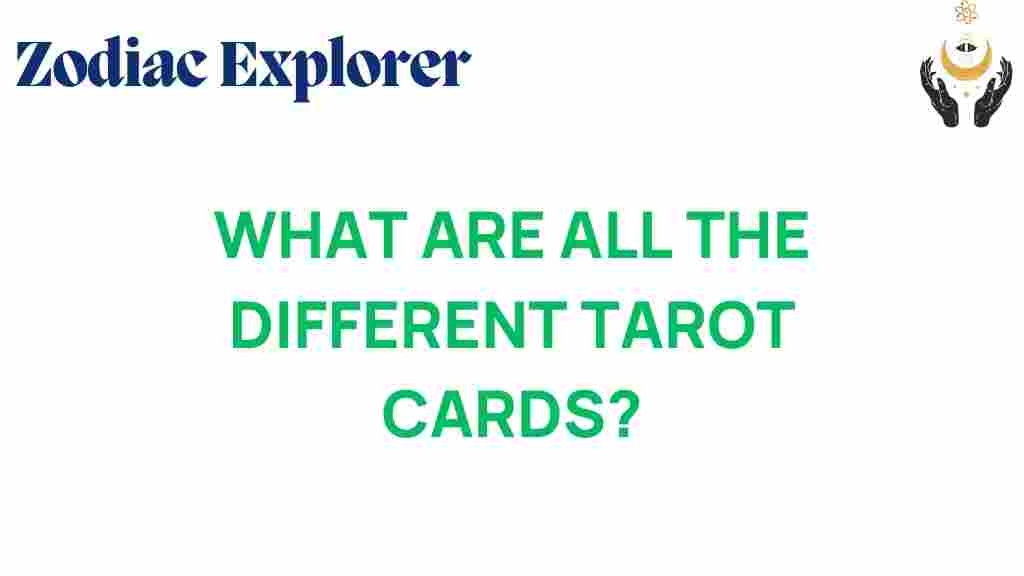Unveiling the Mysteries: What Are All the Different Tarot Cards?
Tarot cards have fascinated people for centuries, serving as tools for divination and insight. Whether you are a seasoned tarot reader or a curious newcomer, understanding the different tarot cards, their meanings, and their symbolic significance is essential for a fulfilling tarot reading experience. In this article, we will explore the fascinating world of tarot cards, diving deep into the major arcana, minor arcana, and the unique symbolism behind each card.
Understanding Tarot Cards
At its core, a tarot deck consists of 78 cards divided into two main categories: the major arcana and the minor arcana. Each card holds its own unique tarot meanings, rich in symbolism and interpretation. Let’s break down these two categories.
Major Arcana
The major arcana consists of 22 cards, each representing significant life events, spiritual lessons, and deep psychological archetypes. Here are the cards in the major arcana:
- The Fool
- The Magician
- The High Priestess
- The Empress
- The Emperor
- The Hierophant
- The Lovers
- The Chariot
- Strength
- The Hermit
- Wheel of Fortune
- Justice
- The Hanged Man
- Death
- Temperance
- The Devil
- The Tower
- The Star
- The Moon
- The Sun
- Judgment
- The World
Each of these cards holds profound meanings. For example, The Fool represents new beginnings and adventures, while The Tower signifies upheaval and revelation.
Minor Arcana
The minor arcana consists of 56 cards and is divided into four suits, similar to a regular deck of playing cards. The suits are:
- Cups
- Wands
- Swords
- Coins (or Pentacles)
Each suit represents different aspects of life:
- Cups: Emotions, relationships, and connections.
- Wands: Creativity, action, and ambition.
- Swords: Intellect, conflict, and decision-making.
- Coins: Material aspects, finances, and practicality.
Each suit contains cards numbered from Ace to Ten, along with four court cards: Page, Knight, Queen, and King. This structure allows for a rich tapestry of meanings and interpretations during a tarot reading.
The Symbolism of Tarot Cards
The power of tarot cards lies not only in their meanings but also in their card symbolism. Each card is adorned with imagery that conveys deeper messages and themes. Understanding these symbols can enhance your tarot reading experience. Here are a few examples:
Symbolism in Major Arcana
- The Fool: A small dog symbolizes loyalty and instinct, while the cliff represents the leap of faith.
- The High Priestess: The moon and water show intuition and the subconscious mind.
- The Tower: Lightning striking symbolizes sudden change and revelation.
Symbolism in Minor Arcana
- Cups: Often depicted with water, representing emotions and intuition.
- Wands: Illustrate growth and creativity, often featuring plants or flames.
- Swords: Represent conflict and intellect, typically shown as sharp blades.
- Coins: Reflect material aspects, often shown with earthy symbols like trees.
By paying attention to these symbols, you can unlock deeper meanings in your tarot readings.
How to Read Tarot Cards: A Step-by-Step Process
Now that we’ve covered the types of tarot cards and their meanings, let’s delve into how to perform a tarot reading. Here’s a simple step-by-step guide:
Step 1: Choose Your Tarot Deck
There are many different tarot decks available, each with unique artwork and interpretations. Choose a deck that resonates with you. Whether it’s the classic Rider-Waite deck or a themed deck, your personal connection to the cards is essential.
Step 2: Set Your Intention
Before you start your reading, take a moment to focus on what you want to achieve. Setting a clear intention helps guide the reading. You might ask a specific question or seek general guidance.
Step 3: Shuffle the Cards
As you shuffle the cards, concentrate on your intention. Some people prefer to shuffle until they feel ready, while others may shuffle for a set amount of time. Trust your instincts.
Step 4: Draw the Cards
There are many spreads to choose from, each offering different insights. A simple three-card spread can provide clarity on the past, present, and future. Alternatively, delve into more complex spreads like the Celtic Cross for deeper insights.
Step 5: Interpret the Cards
Look at the cards drawn and begin interpreting their meanings based on their positions in the spread and their relationships to each other. Utilize your knowledge of tarot meanings and the card symbolism to guide your interpretations.
Step 6: Reflect on the Reading
After interpreting the cards, take time to reflect on the reading. Consider how the messages resonate with your life and situation. It’s important to be open to the insights gained.
Troubleshooting Tips for Tarot Reading
Even experienced readers can face challenges during a tarot reading. Here are some troubleshooting tips to enhance your tarot experience:
- Feeling Confused?: If a card’s meaning is unclear, consult a tarot guidebook or online resource for additional interpretations.
- Overthinking the Cards?: Trust your intuition. Sometimes, the first impression is the most accurate.
- Disconnected from the Reading?: Take a break and return with a fresh perspective. Clearing your mind can lead to better insights.
Conclusion
Understanding the different tarot cards, their meanings, and their symbolism is a journey that enriches your tarot reading experience. Whether you seek guidance for personal issues or want to explore your spiritual path, tarot cards can illuminate the way.
As you delve deeper into the world of tarot, remember to trust your intuition and let the cards speak to you. By embracing the mysteries of the tarot deck, you can unlock profound insights that guide you through life’s challenges.
For further exploration of tarot and its applications, visit this resource for more detailed guides and interpretations. Additionally, you can find a comprehensive guide on divination techniques that include tarot and other methods.
This article is in the category Myths and created by ZodiacExplorer Team
